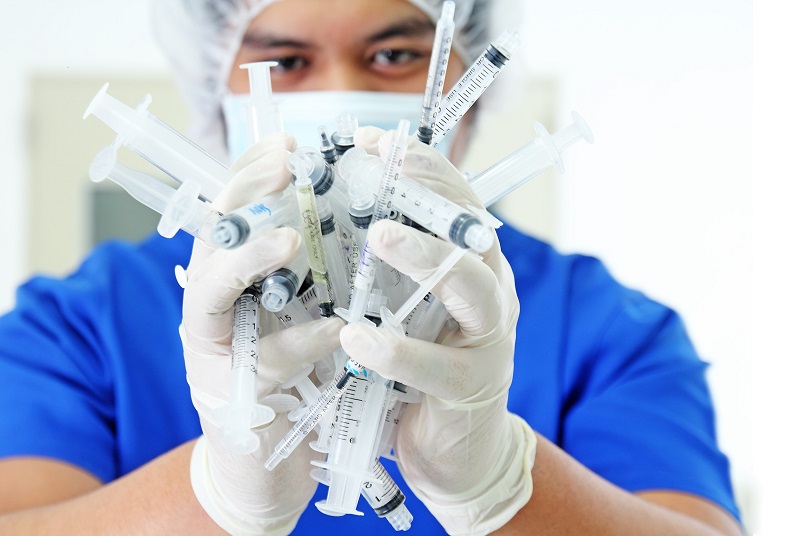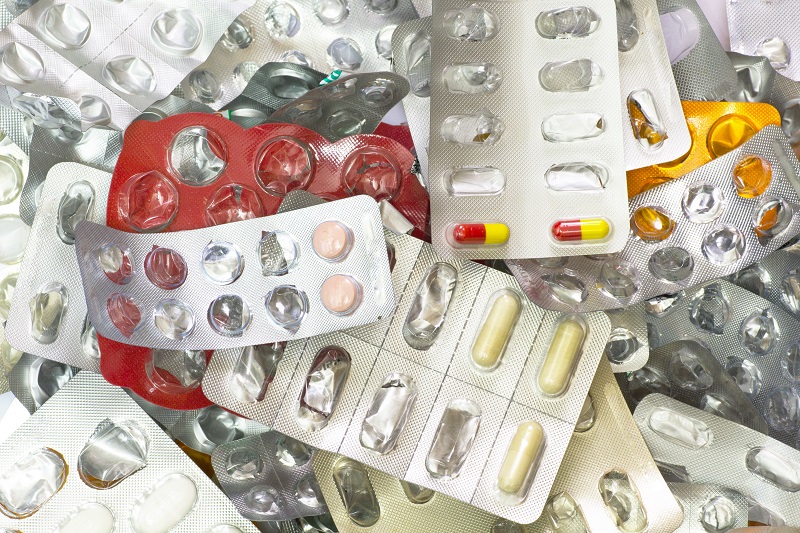Medical centres generate a lot of waste, from food cartons and drink cans to medical equipment packaging and potentially-hazardous objects such as needles, pharmaceuticals and items contaminated with blood and other bodily fluids.
This means that facilities managers in hospitals, health centres, and other care facilities have to have strict protocols in place for segregation and disposal.
Faye Perkins from waste management specialist, Axil-IS, explains: “With hygiene at the forefront of everyone’s mind at the moment, it’s worth going back to basics on the topic, especially in healthcare environments, where dangerous and infectious substances are commonly produced.
“A major part of keeping healthcare facilities sanitary is managing the waste they produce. And, in this sense, what you do with the objects after their use is as important as what you do when using them.”
With hygiene at the forefront of everyone’s mind at the moment, it’s worth going back to basics on the topic
In healthcare, there are four main types of waste, categorised to make disposal safe, hygienic and simple.
“Having these clear waste streams helps to prevent contamination and eliminate human error when disposing of trash,” says Perkins.
In healthcare, these waste streams are:
- Infectious waste
- Non-Infectious waste
- Sharps waste
- Pharmaceutical waste
Aside from these four main waste streams, medical waste is further differentiated by ‘clinical’ and ‘pharmaceutical’ categories.
“If waste is pharmaceutical, it will contain medicinal drugs,” said Perkins.
“There are even sub-categories of waste under this term, including out-of-date pharmaceutical stock, recalled pharmaceutical stock, cytotoxic, and cytostatic waste.”
Small steps like colour-coding bins, employing staff training, and increasing signage can help to effectively segregate waste
The term Clinical Waste refers to waste produced from healthcare activities, including items like swabs, bandages, used PPE, and dressings.
It covers a number of settings such as hospitals and other health facilities, laboratories and research centres, mortuary and autopsy centres, animal research and testing laboratories, blood banks and collection services, nursing homes for the elderly, and veterinary clinics.
Technically, pharmaceutical waste, such as expired drugs or pharmaceutical bins, is also classed as clinical waste, since the waste is a by-product of healthcare activity.
However, not all clinical waste is classed as pharmaceutical.
“The first three categories of medical waste are clinical with the fourth category - pharmaceutical waste - a standalone branch of medical waste,” explains Perkins.
Infectious waste
The term infectious waste is fairly self explanatory, as any substance that can be directly, or indirectly, infectious.
Some examples of infectious waste include human blood waste; sharps used in healthcare; bodily fluids such as saliva or pus; waste products such as vomit, urine and faeces; waste from patients with infections; and pathological waste like skin tissue, organs and body parts.
“In certain circumstances, infectious waste may be deemed highly contagious,” said Perkins.
“This includes situations when infectious waste has a higher possibility of multiplying in a controlled environment like a laboratory or a high-risk ward.”
According to the World Health Organization (WHO), infectious waste or hazardous material accounts for 15% of all clinical waste.
And this type of waste is scrutinised in periods such as the current coronavirus pandemic, as controlling such waste streams is imperative to stopping the spread of disease or infection.
If not disposed of correctly, infectious waste can have adverse effects on us and the environment
“Public preventative measures may include the placement of handwashing stations, the provision of sanitisers, and the hanging of signage,” said Perkins.
“However, these measures don’t help to control the already-infectious waste.
“The provision of personal protective equipment (PPE) may also help to stop the spread of a virus, yet doesn’t relate to the control of infectious waste.
“PPE comes into play when disposing of hazardous waste, as everybody in contact with such waste should wear gloves at the minimum to handle used sharps or other infectious objects.”
Instead, control measures focus heavily on the correct segregation of waste to ensure non-infectious waste doesn’t become contaminated during disposal.
“Small steps like colour-coding bins, employing staff training, and increasing signage can help to effectively segregate waste,” said Perkins.
“Having a dedicated area for the disposal of contaminated waste is also common practice, as well as increasing the frequency of collection in these areas.
“And removing waste more frequently ensures bins are not overfilled. As a guideline, infectious waste should never exceed more than three quarters of a bin.”
Disposing of such waste often requires legally-compliant bags and bins.
For example, orange and yellow bags with symbols are usually supplied for infectious waste.
While yellow refers to infectious, contaminated waste; orange is used for non-contaminated infectious waste.
Red-lidded yellow bins are less common and used in surgical wards to collect anatomical waste, such as an amputated limb.
Disposal methods for these items may include high-temperature incineration or steam sterilisation.
This disposal of infectious waste almost always happens off-site and, in many cases, certified authorities will need to oversee the disposal.
“Although expensive, disposing of infectious waste is mandatory,” said Perkins.
“This is why segregating waste is essential for healthcare settings to ensure they are producing the minimum amount of infectious waste possible.”
She adds: “If not disposed of correctly, infectious waste can have adverse effects on us and the environment.
Without proper waste management, infectious waste could reverse much of the healthcare work we do
“Improper disposal can cause a quicker spread of infection, endangering vulnerable people with low immune systems.
“Mislaid infectious sharps can also lead to injury or — in the worst-case scenario — transmit disease.
“In terms of the environment, poorly-managed waste can cause pollution and poisoning of habitat.
“For this reason, infectious waste is one of the most-important waste streams to get right.
“Without proper waste management, infectious waste could reverse much of the healthcare work we do.
“It can also spread further than a healthcare facility, endangering the space around us.”
Non-infectious waste
This type of waste is often referred to as ‘offensive’ waste.
As classified on the GOV website offensive waste is ‘non-clinical waste that’s non-infectious and does not contain pharmaceutical or chemical substances, but may be unpleasant to anyone who comes into contact with it’.
Some examples include swabs, dressings, nappies, and incontinence pads.
Waste can also include PPE like gowns and masks used on patients, as well as sterilised laboratory waste.
Sterilised Petri dishes, test tubes, and lab coats are other examples.
Perkins said: “Although this type of waste occurs in hospitals and laboratories, the most-common producers of offensive waste are nurseries, care homes and GP surgeries.
“Dentists and fracture clinics may also produce a lot of plaster waste classed as offensive.
“In these facilities, the most-important thing is to separate offensive waste from infectious waste.
“Non-infectious waste must be bagged and weighed to see if it can be disposed of as municipal waste.
“In the UK, 7kg is the maximum load of non-infectious municipal waste.
“If you exceed this weight, non-infectious waste will need to be separated from mixed municipal waste.”
For healthcare providers, this type of waste should be seen as a key opportunity to reduce a facility’s carbon footprint and most can be diverted from landfill and converted instead into new materials.
“While healthcare providers must still take care when handling non-infectious waste, this category isn’t as serious as infectious waste,” Perkins said.
“Hence, the name offensive as the remains of such items are unpleasant, not inherently dangerous.”
Non-infectious clinical waste accounts for the remaining 85% of clinical waste.

Since sharps make direct contact with bodily fluids, more often than not they are also classified as infectious waste and must be disposed of correctly
Sharps
Since sharps make direct contact with bodily fluids, more often than not, they are also classified as infectious waste.
However, some are classed as non-medically contaminated. These could be sharps used to receive daily medicine, or those used as part of routine vaccination.
For healthcare facilities to reach a new standard of hygiene, we need to raise awareness about medical waste across our communities and develop further options to combat the spread of infection
Sharps can range from needles to any type of blade used in a medical setting. For this reason, operating theatres produce a large volume of sharps during surgery as do wards that regularly administer medicine.
Regulations state that sharps need to be controlled and disposed of correctly.
“These pose a risk to the public as infected sharps could spread blood-borne diseases like HIV, hepatitis C (HCV) and hepatitis B (HBV),” explains Perkins.
“On a smaller scale, they can also cause injury.”
For this reason, sharps are carefully controlled in a lidded, puncture-resistant bin. These have no entryway for people to put their hand into the compartment. Yet sharps are easy to deposit after use, keeping the public safe.
These bins are used for non-reusable sharps. Any reusable sharps are robotically emptied and sterilised.
These bins are often UN-approved yellow containers, fixed to the walls of hospitals or other facilities, with the ability to self-lock.
As with infectious waste bins, sharps boxes are emptied by a professional when they are three-quarters full.
Larger facilities will have equipment on site to empty and sterilise sharps.
Most commonly, hospitals will use an autoclave, which uses a combination of pressure and high temperature to purify the contents.
Onsite sterilisation in this way reduces the contact and distance needed for safe disposal.
But smaller facilities, such as GP surgery and care homes, will need the assistance of a waste management company to organise collections independently.
Pharmaceutical waste
Pharmaceutical waste refers to any medicinal drug waste, either hazardous or non-hazardous.
“Non-hazardous pharmaceuticals are usually drugs that are expired, unused or damaged,” said Perkins.
“The most common producers are vets, pharmacies and other facilities where drugs are directly prescribed and dispensed.
“This type of pharmaceutical waste is contained in blue-lidded containers.”
Non-hazardous pharmaceuticals are disposed of by incineration, most commonly carried out off-site by a local authority.
Although this type of waste is lower- risk than hazardous pharmaceutical waste, its contents must still be kept away from the public.
Hazardous pharmaceutical waste is either cytotoxic or cytostatic, meaning the item could be acutely toxic, carcinogenic, mutagenic or toxic for production. Examples include chemotherapy drugs and birth control.
This type of waste is contained in purple lidded containers.

Pharmaceutical waste is labelled either hazardous or non-hazardous and must be correctly disposed of in line with regulations
Hazardous pharmaceuticals are also incinerated. However, this more-dangerous waste stream requires above 1,000-degree incineration to ensure the thorough destruction of its contents.
Purple-lidded bins must be clearly marked with directions for local authorities to incinerate above this temperature and this waste stream must not come into contact with the general public.
“To control pharmaceutical waste, there is a certain hierarchy in place,” said Perkins.
“For example, only qualified pharmacists and other medical professionals can prescribe and dispense drugs, with lower-level staff unable to access restricted areas.
“In this way, the healthcare system ensures that pharmaceutical waste is rarely misplaced or disposed of incorrectly.”
As the current health crisis unfolds, facilities across the globe will need to implement a stricter hygiene routine with a permanently higher hygiene standard
She adds: “Healthcare professionals have long known how medical waste is categorised, as well as how to control each waste stream and its disposal.
“But, for healthcare facilities to reach a new standard of hygiene, we need to raise awareness about medical waste across our communities and develop further options to combat the spread of infection.
“Services such as mist decontamination and further training will help to keep medical environments sanitary while empowering people with the knowledge they need to remain compliant.
“As the current health crisis unfolds, facilities across the globe will need to implement a stricter hygiene routine with a permanently higher hygiene standard.
“To do this, we must first understand the basics and then use this foundational knowledge to innovate.”
